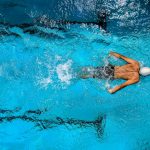In the quest for ultimate performance, athletes are always looking for innovative methods to gain an edge. One such method that is currently gaining traction is hypoxic training. So, how can hypoxic training be safely implemented for swimmers seeking to improve performance? This article delves into the matter, providing clear and practical insights to guide you in your training journey.
Understanding Hypoxic Training
Before diving into the methods of implementing hypoxic training, it is essential to grasp what it entails. Hypoxic training, also referred to as altitude training, is based on the principle of training under conditions of reduced oxygen to stimulate physiological adaptations that can enhance athletic performance.
Lire également : How Can Ultraviolet Light Therapy Be Used for Vitamin D Synthesis in Indoor Athletes?
Several scholarly articles, which you can easily find on Google Scholar or PubMed, have examined the effects of hypoxic training on the human body. They generally agree that when exposed to hypoxia, the body compensates for the lack of oxygen by increasing the production of red blood cells, thereby improving oxygen delivery to the muscles. Some studies have also found that hypoxic training can stimulate the growth of new blood vessels and increase the efficiency of the body’s aerobic energy systems.
How to Implement Hypoxic Training
Now that we’ve understood what hypoxic training is and its potential benefits, let’s look at how you can safely implement it in your swimming routine.
A lire également : What Are the Best Practices for Managing Pre-Competition Anxiety in Elite Gymnasts?
Using Hypoxic Breathing Techniques
One of the simplest ways to introduce hypoxic training into your regimen is by incorporating hypoxic breathing exercises during your regular swimming workouts.
In a typical hypoxic breathing exercise, you would limit your breathing during a set. For example, you might swim a 50-meter length while only taking a breath every three, five, or seven strokes, instead of every stroke. By doing so, you’re effectively reducing your oxygen intake, mimicking the effects of training at a high altitude.
Remember, however, that this type of training should not become a contest to see who can go the longest without breathing. Overdoing it can result in fainting or even drownings. Therefore, these exercises should always be performed under the supervision of a trained coach and within your limits.
Using Hypoxic Training Equipment
Another way to incorporate hypoxic training into your routine is by using specialized training equipment.
These devices, including masks and altitude tents, simulate the conditions of high altitude by reducing the amount of oxygen you breathe in. For example, a hypoxic mask limits the amount of oxygen you can inhale, forcing your body to work harder to deliver oxygen to your muscles.
Keep in mind that while they can be effective, these devices also come with risks. It’s recommended to use them under the supervision of a trained professional who can monitor your response and adjust the settings if necessary.
The Role of Testing and Analysis
Implementing hypoxic training safely requires regular testing and analysis of your performance and health parameters.
You should regularly monitor your heart rate, oxygen saturation, and perceived exertion during your hypoxic training sessions. This will allow you to track your body’s response to the training and make necessary adjustments.
Furthermore, you should also undergo periodic maximal exercise tests, such as a VO2 max test or a lactate threshold test. These tests can provide valuable information about your body’s aerobic performance and how it is being affected by the hypoxic training.
Drawing Insights from Research
In order to ensure that your hypoxic training is effective and safe, it is beneficial to stay up-to-date with the latest research on the topic.
CrossRef, Google Scholar, and PubMed are excellent resources for finding scholarly articles on hypoxic training. You can find studies examining the effects of different types of hypoxic training, the optimal duration and intensity of training, and the potential risks and benefits.
Reading and understanding these studies will provide you with a solid foundation of knowledge that you can use to guide your training. However, because each person’s body responds differently to hypoxic training, it is always best to work with a coach or a sports scientist who can help tailor your training to your specific needs and goals.
Ensuring Optimal Recovery
Lastly, to implement hypoxic training safely, you must pay close attention to recovery.
Hypoxic training places additional stress on your body, particularly on your cardiovascular and respiratory systems. Therefore, it is crucial to ensure that you are getting adequate rest and nutrition to support your recovery.
Moreover, you should pay attention to signs of overtraining, such as chronic fatigue, reduced performance, and mood changes. If you notice any of these signs, it may be necessary to reduce the intensity or frequency of your hypoxic training, or even take a break altogether.
While the effects of hypoxic training can be profound, the key lies in its careful and considered application. It serves as a tool in your training arsenal, but like any tool, it must be used appropriately and safely. With the right approach, hypoxic training can help you unlock new levels of performance, taking your swimming to new heights.
Essential Precautions for Hypoxic Training
It’s worth noting that hypoxic training, while beneficial, carries certain risks that must be mitigated to ensure safe and successful implementation.
One of the most important precautions is to avoid overdoing it. Whether it involves reducing your breathing while swimming or using altitude simulation devices, it is critical not to push yourself too hard. Over-training in hypoxic conditions can lead to serious consequences such as fainting, severe exhaustion, or in extreme cases, cerebral or pulmonary edema.
Speaking of altitude, it’s also crucial to note that people respond differently to reduced oxygen levels. This is largely due to various factors like genetics, body mass, and overall health and fitness levels. Hence, what works for one athlete may not necessarily work for another. Therefore, tailoring your hypoxic training to your personal needs and capabilities is essential.
In addition, if you’re using hypoxic training equipment, always do so under the guidance of a trained professional who can monitor your response to the conditions. Particularly, the use of masks and altitude tents, which essentially simulate normobaric hypoxia. These devices lower the amount of oxygen you breathe in, which may cause discomfort, and in some situations, can be hazardous. Hence, a professional can appropriately adjust the settings of the device and keep an eye on your overall well-being.
Furthermore, a systematic approach to testing and analyzing your performance and health parameters during hypoxic training sessions is essential. Regularly monitoring your heart rate, oxygen uptake, and perceived exertion can provide valuable insight into how your body is responding to the training and allow for necessary adjustments to be made.
Conclusion: The Key to Safe and Effective Hypoxic Training
In conclusion, hypoxic training offers a promising avenue for swimmers seeking to improve their performance, primarily by enhancing aerobic capacity and efficiency. However, its implementation should always be guided by prudence, individual customization, and professional supervision.
It’s essential to balance between training intensity and recovery, ensuring you are not pushing your body beyond its limit. Always remember to pay attention to signs of overtraining and prioritize rest and recovery.
Continuous learning is also crucial. By staying updated with the latest research on hypoxic training from reliable sources like Google Scholar, PubMed, and CrossRef, you can make informed decisions about your training regimen.
Lastly, consider working with a coach or a sports scientist who can help tailor your training to your specific needs and goals. They can offer expert guidance, from interval training programs to the proper use of training equipment.
To reiterate, while hypoxic training can potentially elevate your swimming performance, it is not a magic bullet. Like all training methods, its effectiveness comes down to how it is implemented. Approach it with patience, caution, and an openness to learning, and you may find it a valuable addition to your training arsenal.
















